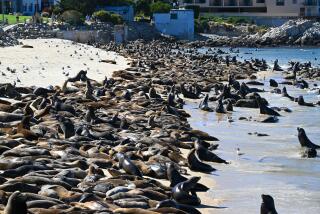Manhattan Beach Has the ‘Jaws’ Jitters After 2 Great Whites Surface
Landing two great white sharks near the Manhattan Beach Pier was a thrill for fishermen David Bird and Mike Walker, but it created oceans of angst in a community where many residents seem to spend nearly as much time in the water as they do on land.
Lifeguards said word spread quickly of the capture last Friday of the two sharks--one 6 feet, 10 inches long, the other 7 feet, 10 inches--and many fearful beachgoers pledged to avoid the water.
Marine experts, however, said swimmers have nothing to fear from the fish, although they acknowledged that it is unusual to find sharks that large so close to shore.
Bird and Walker, both pier regulars, began casting for bonito and mackerel about dawn. After they caught an ample supply, Walker, 34, of Manhattan Beach baited his line with mackerel and cast out again from the end of the pier.
Strong Tug
“I could tell it was something very large,” he said of the tug on his line, “but I thought it would just be a bonito shark.”
Ninety minutes later, at about 11 a.m., the two fishermen had to walk off the pier and onto the beach before dragging a 150-pound shark onto the sand. They immediately recognized the razor teeth and large head of the bonito shark’s more infamous cousin.
Minutes later, Bird, a 24-year-old from Torrance, returned to the pier and felt a strong pull on his own line. He fought for more than two hours and ended up a quarter-mile down the beach before landing the second great white shark, which was at least 100 pounds heavier than Walker’s.
The two friends cleaned both fish and found the stomachs empty. Bird then trucked the sharks to San Pedro, where they brought $150 at a wholesale fish market.
“It’s an anomaly in the sense that we don’t usually find animals that size caught from a pier,” said Ralph Collier of Canoga Park, president of a group known as the Shark Research Committee. “Unfortunately, none of us really knows very much about the life history of these animals.”
Collier said that an attack on humans is highly unlikely in Southern California. In the last 60 years, there has not been a single documented great white shark attack on the coast south of Point Conception, he said. Since 1975, there have been two attacks at the point, which is just north of Santa Barbara, and two more at San Miguel Island. None were fatal.
Natural Food
“Because a shark is caught offshore does not mean it is venturing into the bathing areas,” Collier said. “Human beings are not natural food to sharks, otherwise we would have daily reports of people being consumed by sharks.”
Great white sharks usually do not begin to eat seals and other mammals until they reach 12 feet or more in length, according to Donald Nelson, a biology professor at California State University, Long Beach. The sharks grow as large as 18 feet long and can weigh 4,000 pounds.
Attacks by the big sharks have been more common in Northern California, where great whites venture closer to shore. The last reported attack was off Tunitas Beach on Aug. 15, when a shark attacked a surfboard, injuring the hand of its owner.
Although many beachgoers were alarmed by the Manhattan Beach catch, some took it in stride, lifeguard Tom Hargett said.
“They’re not worried about ‘Jaws,’ they’re more worried about the pollution,” he said, referring to recent sewage spills that closed the beach.
Walker, an unemployed construction worker, and Bird, who assembles telescopes part-time, were back on the pier fishing on Wednesday.
“I’m real excited about it still,’ Bird said. “I’d like to catch another one.”
More to Read
Sign up for Essential California
The most important California stories and recommendations in your inbox every morning.
You may occasionally receive promotional content from the Los Angeles Times.











